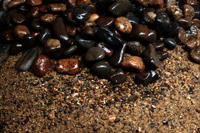Concrete is a mixture of two components: aggregates and paste. The paste, comprised of cement and water, binds the aggregates (usually sand and gravel or crushed stone) into a rocklike mass as the paste hardens.
A properly proportioned concrete mix possesses acceptable workability of the freshly mixed concrete and durability, strength, and uniform appearance of the hardened concrete while being economical.
Materials for Use in Concrete
Aggregates

Aggregates are classified by ASTM C33 (AASHTO M 6/M 80) as fine or coarse. Fine aggregate consists of natural sand, manufactured sand, or a combination thereof with particles that are typically smaller than 0.2 inches. Coarse aggregate consists of either (or a combination of) gravel, crushed gravel, crushed stone, air-cooled blast furnace slag, or crushed concrete, with particles generally larger than 0.2 inches. The maximum size of the coarse aggregates is generally in the range of 3/8 to 1 ½ inches. Read more on why we use aggregates in concrete.
Concrete as a Carbon Sink
The topic of global climate change is frequently in the news. The International Panel on Climate Change (IPCC) reports that the increase in the concentration of many compounds in the atmosphere will impact global climate. The most notable of the long-lived greenhouse gases are carbon dioxide and methane. Using concrete for building structures and infrastructure can contribute to the emission of carbon dioxide. Almost all construction processes from manufacturing, through transportation of materials and installation use energy, and much of this energy may come from the burning of fossil fuels.
What most people do not realize is that the release of CO2 from calcination in the manufacture of portland cement may be part of a cyclic process and is partially carbon neutral in smaller timeframes such as decades. It may be fully carbon neutral in longer timeframes. Concrete can absorb carbon dioxide and store it in a process commonly referred to as carbonation. This may be viewed simply as an additional, alternative loop of the complex carbon cycle. Carbon dioxide may be absorbed by concrete in its many forms such as buildings, bridges and pavements. Concrete does not even necessarily have to be directly exposed to the atmosphere for this process to occur. Underground concrete piping and foundations can absorb CO2 from air in the soil, and underground and underwater applications might absorb dissolved carbon dioxide (carbonates) present in groundwater, freshwaters and saltwaters. Read more on carbon dioxide and concrete.
Recycled Aggregates

Construction materials are increasingly judged by their ecological characteristics. Concrete recycling gains importance because it protects natural resources and eliminates the need for disposal by using the readily available concrete as an aggregate source for new concrete or other applications.
Click here for more on recycled aggregates.
Self-Consolidating Concrete
 Self-Consolidating concrete (SCC) is a high-performance concrete that can flow easily into tight and constricted spaces without segregating and without requiring vibration. The key to creating self-consolidating concrete (SCC), also referred to as self-compacting, self-leveling, or self-placing concrete, is a mixture that is fluid, but also, stable, to prevent segregation.
Self-Consolidating concrete (SCC) is a high-performance concrete that can flow easily into tight and constricted spaces without segregating and without requiring vibration. The key to creating self-consolidating concrete (SCC), also referred to as self-compacting, self-leveling, or self-placing concrete, is a mixture that is fluid, but also, stable, to prevent segregation.
What is Self-Consolidating Concrete (SCC) and how is it tested?
Ultra High Performance Concrete
Ultra High Performance Concrete (UHPC), also known as reactive powder concrete (RPC), is a high-strength, ductile material formulated by combining portland cement, silica fume, quartz flour, fine silica sand, high-range water reducer, water, and steel or organic fibers. The material provides compressive strengths up to 29,000 psi and flexural strengths up to 7,000 psi.
The material's unique combination of superior properties and design flexibility facilitated the architect's ability to create the attractive, off-white, curved canopies. Overall, this material offers solutions with advantages such as speed of construction, improved aesthetics, superior durability, and impermeability against corrosion, abrasion and impact—which translates to reduced maintenance and a longer life span for the structure. Read more on ultra-high performance concrete.